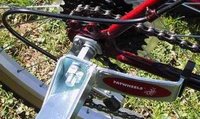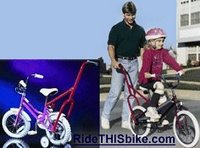Recently, a customer from Memphis asked me to help find training wheels for the 16" Giatex Sport 550 that she had just purchased. According to her neighborhood bike shop, training wheels would not fit. As a result of assisting her, I learned about 2 new products and more about teaching kids to ride bicycles.
Not having a set of training wheels handy, I asked a business associate for advice. Since standard training wheels interfere with the movement of the derailleur, my associate suggested that the customer install the wheels over the derailleur and accept that the bike would stay in the same gear until training wheels were no longer needed. Every bike with training wheels is a single speed anyway, right? WRONG.
Searching for training wheel alternatives, I discovered 2 products: Fatwheels & the ReadyRider. Both can be used with multi-speed bikes that use derailleurs to change gears.
 Fatwheels are training wheels on steriods. Using a combination of larger, better tires and stronger braces, they're far more stable/durable than the traditional, narrow, solid rubber training wheels most of us have either seen or used. Fatwheels roll more easily than traditional training wheels and can be used on a wider variety of riding surfaces making them the first choice for safety conscious parents, regardless of the riding surface. They can even accommodate the weight of an adult.
Fatwheels are training wheels on steriods. Using a combination of larger, better tires and stronger braces, they're far more stable/durable than the traditional, narrow, solid rubber training wheels most of us have either seen or used. Fatwheels roll more easily than traditional training wheels and can be used on a wider variety of riding surfaces making them the first choice for safety conscious parents, regardless of the riding surface. They can even accommodate the weight of an adult. Cost (incl the extender needed to clear the derailleur and shipping in lower 48 states): $95
 ReadyRider is a handle that can be used to steady and propel a rider from behind. It attaches to the rear axle of the bicycle and the seat post and can be used with or without training wheels.
ReadyRider is a handle that can be used to steady and propel a rider from behind. It attaches to the rear axle of the bicycle and the seat post and can be used with or without training wheels. Cost (incl shipping in lower 48 states): $25
Test Results
Although I didn't test the Fatwheels, the ReadyRider worked well, attaching quickly and free of problems. I think my 6 year old will learn to balance on his bike much faster with the ReadyRider than with training wheels.
Teaching/Learning To Ride
Safe bicycling takes considerable coordination, agility, balance and judgement. If you're looking to teach someone to ride a bicycle, use more than the potential rider's age to assess their ability to ride free of training aids or assistance. You may find it beneficial to read "Teaching Kids to Ride" by Sheldon Brown. Sheldon has been writing about cycling for years and offers excellent advice on a wide range of cycling subjects.
http://www.sheldonbrown.com/teachride.html
By the way, with respect to kids' abilities for cycling, ibike.org (a very large bicycling info site) has this to say: "Most kids try two-wheeler with training wheels around age 3 years... Between the ages of 4 and 8 years most kids develop sufficient physical coordination and agility, good balance, and master starting and stopping on a tricycle or training wheels and are ready to learn to ride. (Note: Kids generally lack the coordination and strength for hand brakes until at least 5.) But, along with physical skills it also takes mental readiness and motivation to learn to ride."
++++++++++++++
Looking for a great starter bike...
Whether you're looking for the first 2 wheel bike for your tike or a bike for an adult, the Giatex is the only bike for the job. The 16" Giatex Sport 550 will stretch from a compact size for preteens to accommodate riders up to 6' 4" and 205 lbs. For more info about sturdy, light and practical folding bikes under $300, visit RideTHISbike.com.
++++++++++++++
No comments:
Post a Comment